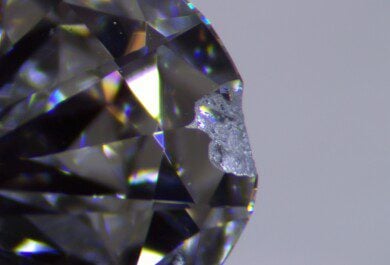On the basis of the above estimation of the outcome, we calculated the final value of the polished, and compared it to our cost. Seeing that we would end up with a lot of stones with a highly desirable colour-clarity-combination, and that we foresaw a profit of 15% on this parcel, we gladly bought the parcel.
The decision was quickly made: we had to buy this parcel.
After cutting the stones, we always estimate the stones ourselves before shipping them to AGS. These were the results.
In weight, we ended up with a total finished weight of 48.94 Carats, thus a yield of 35.40% , which was a tad higher than the expected 34.65%.
In colour, we estimated the final colour (in our figure-system) at 4.53. We had estimated a colour of 4.58. Roughly, we could say that we ended up exactly with the average G-H-colour, which we had predicted.
In clarity, we had predicted a clarity of 6, which stood for SI1 in our system. After cutting, we estimated the final clarity at 6.21, thus a little lower than SI1.
All in all, we were very happy with the outcome, although the slightly lower clarity already lowered the $-outcome of our parcel by 6%. Still, we did consider this a good buy, especially since we are very comfortable with our estimates before sending to AGS, and we generally get the same results on our grading reports.
The final grading of AGS
To our astonishment, the grading of AGS seemed to have become a tad stricter than we were used to in the past. These were our results.
In colour, in stead of the predicted colour of 4.53, we received an average grade of 5.12, thus an average of H in stead of G-H. Generally, we have the experience that AGS gives a slightly better colour-grade than our estimate, and this difference is very surprising to us.
In clarity, we predicted a clarity of 6.21, and AGS graded the parcel at an average grade of 6.58. Normally, we are used to AGS grading clarity slightly stricter than our prediction, thus this does not surprise us at all.
However, where we generally get a somewhat stricter grade on clarity, and a slightly better grade on colour, we now got a stricter grade on both.
When looking at this dollar-wise, the picture becomes problematic. Before sending the stones to AGS, we estimated our return to be 94% of our original prediction. With the resulting AGS-grades, our return now is only 83% of our original prediction.
We had estimated to turn a profit of 15% on this parcel. Now, it turns out to be a loss of 5%.
Conclusion
It is frightening to see how a slight error in the estimation of rough can make such a big difference in dollars.
Now, this is not something to mourn too much about, since sometimes estimates can be incorrect in the other direction too, and this would lead to unexpected profits.
And, the good thing is, that we now do have a number of very interesting stones available, in highly desirable colours and clarities, and these should be very easy to sell.











